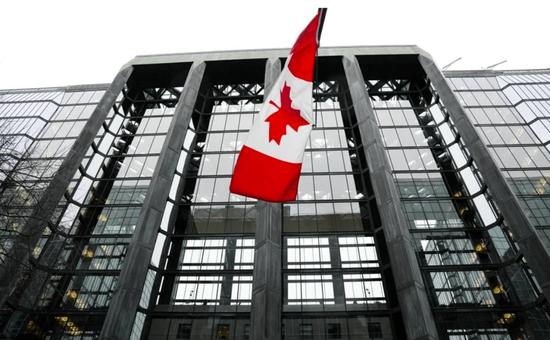
In the recent volatility in financial trading markets, the Canadian dollar appears to have taken a "shrug" attitude to economic data, and this phenomenon is particularly evident in the market reaction to the release of Canadian retail sales data. The US dollar and Canadian dollar reached an intraday high of 1.4408 on the eve of the data release, and the exchange rate did not move significantly after the data release. This situation not only caused widespread concern in the market, but also prompted us to delve deeper into the economic logic behind the Canadian dollar's lukewarm response to economic data.
First, the risk of tariffs has become one of the key factors affecting the direction of the Canadian dollar. U.S. President Donald Trump has repeatedly threatened to impose tariffs on Canadian goods, and the uncertainty over this policy has put tremendous pressure on the Canadian economy. While the market generally sees Trump's tariff threat as more of a strategic bluff, it should not be ignored that the Trump administration's trade policy has been volatile and often surprises the market. Therefore, the impact of tariff risk on the Canadian economy cannot be underestimated.
The potential implementation of tariffs will have a direct impact on Canada's export industry. As a country with high dependence on trade, Canada's economic growth largely depends on trade with the United States. Once the tariffs are in place, the cost of Canadian exports will rise, making Canada less competitive in international markets. This will not only lead to a reduction in exports, but may also trigger a chain reaction, affecting domestic employment, production and consumption.
More seriously, the risk of tariffs could also trigger market panic. In the context of heightened uncertainty, investors tend to choose safe haven assets, and the US dollar, as one of the world's most important safe haven currencies, will naturally be favored. This will cause the US dollar to rise against the Canadian dollar, putting further downward pressure on the Canadian dollar. As a result, while economic data may show that Canada's economy remains solid, in the shadow of tariff risk, the market will often take the data with caution or even choose to ignore it.
In addition to tariff risks, the implementation of the GST holiday is also an important factor affecting the direction of the Canadian dollar. In order to stimulate consumption and economic growth, the Canadian government has decided to eliminate value-added tax on many goods for a specified period of time. While such a policy could boost consumer purchasing power and retail sales in the short term, it could create a host of complications for the economy in the long run.
The implementation of a GST holiday can distort market signals and lead to abnormal behavior among consumers and businesses. During the tax holiday, consumers may buy goods that they had planned to buy in the future in advance, thus overdrawing future consumption demand. While this concentrated release of consumer behavior can boost retail sales in the short term, it may lead to weak consumer demand and excess capacity in the retail sector in the long run. At the same time, enterprises may also adjust production plans because of the existence of tax holidays, further aggravating the risk of market supply and demand imbalance.
In addition, GST holidays have a complex effect on inflation. During the tax holiday, the Consumer Price Index (CPI) may be temporarily lower due to falling commodity prices. However, with the end of the tax holiday, commodity prices will rise again, and there may even be a retaliatory rebound. Such price fluctuations will not only affect the purchasing power of consumers and the pricing strategies of enterprises, but also may cause difficulties for the monetary policy making of central banks.
The impact of the GST holiday has made the interpretation of Canada's economic data more complicated. Retail sales data, an important measure of consumer demand, can be heavily distorted during the tax holiday. As a result, the market needs to be more careful when analyzing these data to avoid being fooled by superficial exuberance. At the same time, due to the lag and uncertainty of the impact of the consumption tax holiday on inflation, the central bank also needs to fully consider this factor when formulating monetary policy to avoid overreacting or misjudging the situation.
Under the dual pressures of tariff risk and GST holidays, the Bank of Canada's job has undoubtedly become more difficult. On the one hand, the central bank needs to pay close attention to the changes of economic data to accurately judge the economic situation and formulate corresponding monetary policies; On the other hand, the central bank also needs to deal with the impact of external risks on the domestic economy, and ensure the stability of financial markets and the sustainability of economic growth. However, in the current complex and volatile economic environment, it is difficult for central banks to have it both ways.
First, central banks need to be more cautious and comprehensive in their interpretation of economic data. Due to tariff risks and the impact of the consumption tax holiday, economic data may not accurately reflect the true state of the economy. Therefore, central banks need to make integrated judgments in conjunction with other sources of information and market dynamics to avoid being misled by a single piece of data.
Second, central banks need to be more flexible and forward-looking in setting monetary policy. In the face of external risks, central banks need to quickly adjust the stance of monetary policy in response to potential economic shocks. At the same time, the central bank also needs to pay attention to the development trend of the future economic situation to ensure the pertinence and effectiveness of monetary policy. However, in the current economic environment, the central bank's monetary policy space has been severely squeezed. With interest rates already at a low level and limited room to cut rates, the central bank may face greater challenges in dealing with downside risks to the economy.
In summary, the Canadian dollar's "dismissive" attitude to economic data is not for nothing. Under the double pressure of the tariff risk and the GST holiday, the market impact of the Canadian economic data has rapidly diminished. This phenomenon not only reflects the complexity and uncertainty of the current economic environment, but also highlights the challenges and difficulties faced by central banks in formulating monetary policy. Therefore, we need to have a deeper understanding of the logic and mechanisms behind these economic phenomena in order to better cope with future economic challenges. At the same time, the government and the central bank also need to strengthen communication and coordination, jointly cope with the impact of external risks on the domestic economy, and ensure the stability of the financial market and the sustainability of economic growth.

报告显示,中国电力投资加速增长,预计2024年电网基建投资将超过5300亿元。
近日,市场迎来了一则引人注目的消息:工业巨头3M公司(MMM.N)在本周五公布了其季度业绩报告,随后股价飙升至近两年来的
最近,外媒给OpenAI算了笔账,今年可能要血亏50亿美元。
近日,巴黎奥运会和世界铁人三项协会联合发布了一项重大决定,宣布因塞纳河水质污染问题,原定于近期进行的奥运会铁人三项首次下
当地时间7月18日,法国巴黎发生了一起令人震惊的持刀袭警事件。
近期,一则重大消息在国际舞台上引起轩然大波,马来西亚宣布加入金砖国家。
调查发现,互联网和智能手机的使用干扰了韩国近五分之一学生的生活。